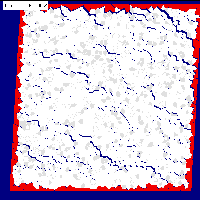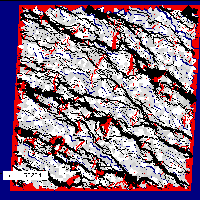Mark Hopkins
CRREL
The granular model is based on a discrete element approach in which individual parcels of first-year and multiyear ice are explicitly modeled. In a nutshell, the granular model takes the continuum assumption from the pack scale down to the floe scale. The yield surface and flow rule which are of paramount importance for large-scale models are not needed in a granular model. They are replaced by floe scale failure processes. The individual ice parcels may freeze together, overlap to raft or form pressure ridges, split or separate to form leads depending on the dynamic conditions. Coulomb frictional forces resist sliding between ice parcels. The model ice pack is driven by boundary deformations, winds and currents. Because the model explicitly simulates an assembly of thousands of ice parcels with a distribution of sizes, shapes, and thicknesses it is inherently anisotropic. In its current form the granular model is capable of simulating a 50 km x 50 km area of the ice pack at a rate of about 1 minute of CPU time per day on a desktop computer.
Advantages of a Granular Model:
( Spatial resolution at the scale of individual ice parcels.
( Surface stress resolution at the scale of individual ice parcels.
( Internal stress resolution with 'smart' FEM floes.
( Direct coupling of floes with wind and water drag.
( Explicit location and energetics of ridge formation allows integration with ambient noise
models.
( Unlimited scalability: As computer power increases so can scope and detail.
( The ability to directly incorporate SAR data into simulations.
( The ability to integrate parameterizations of smaller-scale behavior such as freeze and
melt, ridging, rafting, and floe splitting.
( A natural transition between a fully consolidated pack and the 'loose' conditions of the
MIZ and the late summer pack.

Figure 1: A snapshot from a simulation in which a 200 km x 200 km model ice pack is
undergoing simple shear with dilatation. Large-scale lead development is evident. The
strain rates are (u/(y=1.0x10-6 /s and (v/(y = 0.5x10-6 /s.

Figure 2: A snapshot from the same simulation showing the lines of force propagating through the model ice pack. The black lines represent compressive forces and the red lines represent tensile forces. The line width is proportional to the magnitude of the force.
An animation of this simulation can be viewed on the WEB at the following location: